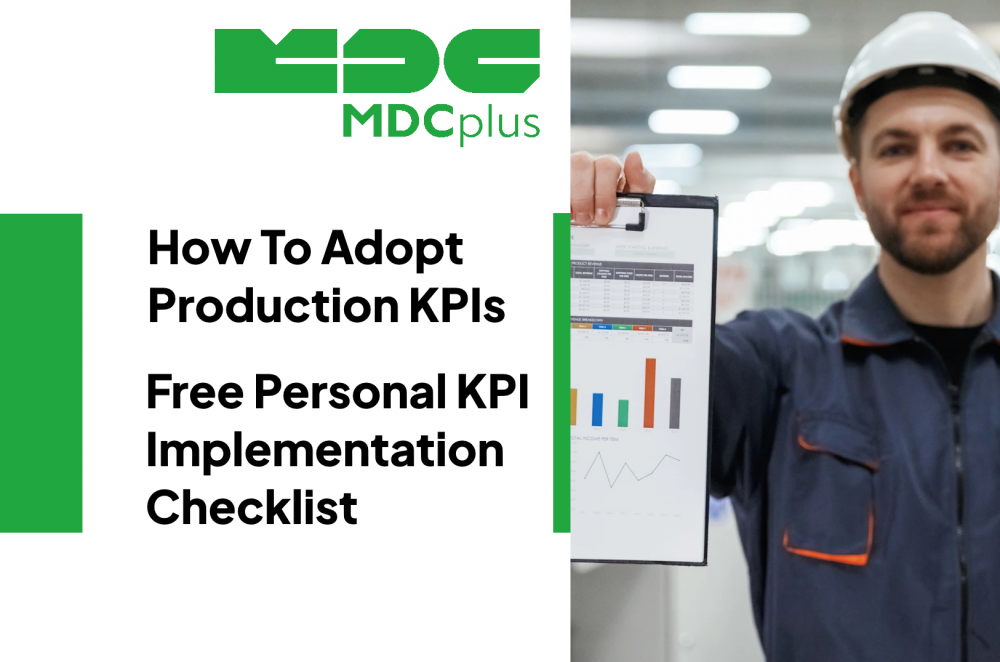How To Adopt Production KPIs + Free Implementation Checklist
In modern manufacturing, “working by feel” is a fast track to missed opportunities and inefficiencies. KPIs (Key Performance Indicators) do more than report numbers — they act as levers, converting raw data into actionable decisions. But deploying KPIs is not just “turning on gauges.” Without structure and discipline, metrics devolve into noise or even distort behavior.
Standards Connection
If you’re already familiar with ISO 22400, ISA 95 or ISA 88, you’re ahead. KPIs often live in the operational / execution layer, and ISA 95 defines how data flows between MES / ERP levels. ISO 22400 offers a foundational metric set for manufacturing: availability, performance, quality, etc. If no - we have dedicated articles for you - here and here - and in this article, we build on that foundation and show how to operationalize it in real settings.
Core Principles & Common Mistakes
-
KPIs must be managerial, not ornamental. If a metric doesn’t drive decisions, it doesn’t belong.
-
Use the SMART framework: Specific, Measurable, Achievable, Relevant, Time-bound
-
Limit the number of KPIs. A few well-chosen metrics (5–7) beat dozens of superficial ones.
-
Blend leading and lagging indicators. Leading KPIs allow course correction; lagging validate outcomes.
-
Automate data capture. Manual data entry is an error magnet.
-
Account for exceptions and adjustments. Downtime, shifts, outlier events must be handled gracefully.
Typical pitfalls:
– KPIs are defined top-down without input, so team sees them as “dictated.”
– Formulas are overly complex or include too many assumptions.
– Data is messy, inconsistent, or incomplete.
– People start “gaming the metric” rather than improving the real objective.
– KPIs go live, then get ignored because nobody maintains them.
Phases of KPI Implementation - With Checklist
Here is the link to download our checklist:
We structure implementation into five phases:
- Preparation — leadership defines strategic goals, team formation, data audit
- Design — generate candidates, pick core metrics, define sources, test formulas
- Pilot / Testing — roll out in a limited scope, collect feedback, refine
- Deployment / Scaling — automate, assign access, embed in manage routines
- Support & Evolution — audit, refine, retrain, evolve as processes change
Each phase is essential. Skipping a pilot, for example, risks deploying flawed metrics into full operations.
Practical Tips & Traps
- Involve front-line roles (operators, shift leads) early — they’ll be users of the KPIs.
- Start with metrics that require minimal manual input.
- Use thresholds, filters, and anomaly detection to suppress noisy outliers.
- Establish a routine KPI review schedule (e.g. semi-annual) so metrics evolve with the process.
- Cultivate a data culture — metrics as tools for improvement, not blame.
- Avoid overreaction when a KPI is bad — use it as a trigger for investigation, not punishment.
Use Cases
Example 1: A production line introduced a KPI for OEE but didn’t adjust for changeovers or shift variability — the metric looked bad and was eventually ignored. After adding exception logic and rebalancing, the KPI became meaningful and drove improvement in downtime.
Example 2: A plant tracked “setup time” but didn’t capture the preparatory work. Operators “rushed” changeovers and quality slipped. When the KPI formula was enriched to include prep time, it aligned incentives correctly and led to more realistic improvement.
KPI Adoption in Your Organization
- Transparency: Communicate how each metric is calculated and why it matters
- Training: Run sessions for operators, supervisors, and managers
- Feedback loops: Collect user input and refine the KPI definitions
- Visibility: Dashboards, display boards, reports — let KPIs be seen
- Process integration: Don’t treat KPIs as a standalone topic — they must live inside management routines
- Continuous evolution: Recognize that business, processes, and technology change. KPI definitions must evolve, too.
Conclusion
Implementing KPIs is not “just installing software.” It’s a disciplined journey: strategy, design, pilot, rollout, and constant care. If you’re planning your first KPI initiative, start small with a pilot, iterate, and build over time.
About MDCplus
Our key features are real-time machine monitoring for swift issue resolution, power consumption tracking to promote sustainability, computerized maintenance management to reduce downtime, and vibration diagnostics for predictive maintenance. MDCplus's solutions are tailored for diverse industries, including aerospace, automotive, precision machining, and heavy industry. By delivering actionable insights and fostering seamless integration, we empower manufacturers to boost Overall Equipment Effectiveness (OEE), reduce operational costs, and achieve sustainable growth along with future planning.
Ready to increase your OEE, get clearer vision of your shop floor, and predict sustainably?
